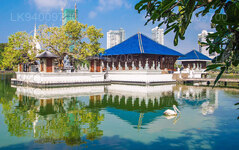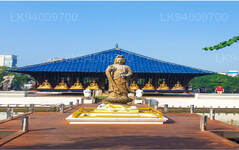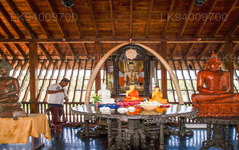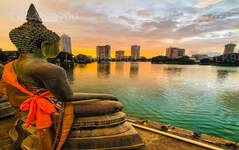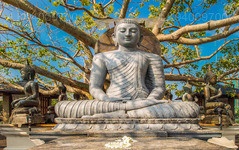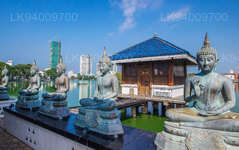
/páginas/transferências
Colombo, a capital do Sri Lanka, é uma cidade dinâmica que mistura tradição e modernidade. Ela exibe arquitetura colonial, mercados animados e templos budistas serenos. Com uma gastronomia diversificada, um horizonte crescente e belas praias, é um centro vibrante de negócios, cultura e turismo, oferecendo uma porta de entrada para explorar as maravilhas do Sri Lanka.
Seema Malaka
Within the heart of Colombo is the Gangarama Buddhist Temple. Built during the late 19th century for the Buddhists who lived in the capital city of Colombo; the temple sprawled over a large area of land and included several outer structures. The Seema Malaka is one of these. Originally, it was built with a foundation within the floor of Beira Lake, and was the image of stolidity. However, it was not able to withstand the marshy ground underneath the lake. By 1970 the Seema Malaka had sunk completely under the waters of Beira.
And then in 1976, Sir Geoffrey Bawa was hired to do this difficult construction design. He created three floating platforms interlinked by pontoon walkways and anchored to the base of the lake by way of stone pillars.
The light design ensured that the construction would not sink. The entire structure is connected to the shore using another pontoon bridge. He created a design that emulated the ancient monasteries of Anuradhapura and added his own signature modern twirl to it. Bawa was one of the most influential Asian architects of the mid to late 20th century and was well known for founding Tropical Modernism. This style is very apparent in the deep blue clay roof tiles of the main temple, the simplistic and yet delicate structure made of a collection of wooden spindles and banisters that lets plenty of air and light in, and the overall design that conforms to nature instead of fighting against it.Things to See
- The Central Platform: This platform has a number of Asian seated stone Buddhas along the perimeter of the platform. They are beautifully sculpted and come out well in photos. In the center is a room with slatted wooden walls. This comfortable place is used for meditation and yoga by visitors and devotees. It provides a relaxing view of the lake and its surroundings. It also has a beautiful large Buddha statue flanked by two giant elephant tusks. Before entering this room, you can take note of the Anuradhapura style dwarf guardian statues at the entrance; which are perfectly formed.
- The Northern Platform: This platform is sealed and is said to lead to the Treasury of the Truth. This houses a library of Buddhist texts and is only accessible by monks.
- The Courtyard: This is where the main part of Seema Malaka is. To one side of the courtyard, a comparatively small offshoot of the original sacred Bo tree in Anuradhapura grows out of a raised platform draped in prayer flags. It is flanked by Buddha statues of varied sizes – the biggest of which stands magnificently next to a small stupa. The courtyard has small rooms with wooden doors at the four corners. Within these are localized versions of Hindu Gods that the Buddhists worship as Devas. Just behind the main courtyard is a tier of stacked-up Buddha statues from Thailand. Close to this is the temple’s most surprising feature; a collection of vintage cars, presented by well-wishers over the years
- The Museum: On the way out of the entrance you can visit the museum. The temple museum has two big rooms overflowing with a treasure-trove of interesting objects; some collected for their symbolism, some for their artistic and/or financial value, and some just because. These include collections of ancient Sanskrit Ola leaf manuscripts, large sapphires and other precious stones, sandalwood and ivory carvings, brass statuettes of gods, jade & crystal monstrosities, elephant tusks, coins, innumerable Buddha images & statues of other Buddhist & Hindu deities, oil lamps, votive pagodas, old clocks, porcelain, ivory carvings, and even old gramophones. Overall they form what feels more like a cave of treasures that is definitely worth looking at.
Sobre o Distrito de Colombo
Colombo é a maior cidade e capital comercial do Sri Lanka. Está localizada na costa oeste da ilha e adjacente a Sri Jayewardenepura Kotte, a capital do Sri Lanka. Colombo é uma cidade movimentada e vibrante, com uma mistura de vida moderna e edifícios e ruínas coloniais, e uma população de 647.100 habitantes. A Região Metropolitana de Colombo, definida pelos distritos de Colombo, Gampaha e Kalutara, tem uma população estimada de 5.648.000 habitantes e cobre uma área de 3.694,20 km². Colombo é uma cidade multiétnica e multicultural. É a cidade mais populosa do Sri Lanka, com 642.163 habitantes vivendo dentro dos limites da cidade. A população de Colombo é uma mistura de vários grupos étnicos, principalmente cingaleses, mouros e tâmeis. Há também pequenas comunidades de pessoas de origem chinesa, portuguesa, holandesa, malaia e indiana vivendo na cidade, bem como numerosos expatriados europeus. A grande maioria das empresas cingalesas tem sua sede em Colombo. Algumas das indústrias incluem produtos químicos, têxteis, vidro, cimento, artigos de couro, móveis e joias. No centro da cidade está localizado o segundo edifício mais alto do sul da Ásia: o World Trade Center.
Sobre o Distrito de Colombo
A Província Ocidental é a província mais densamente povoada do Sri Lanka. Abriga a capital legislativa, Sri Jayawardenepura Kotte, e Colombo, o centro administrativo e comercial do país. A Província Ocidental é dividida em três distritos principais: Colombo (642 km²), Gampaha (1.386,6 km²) e Kalutara (1.606 km²). Como centro econômico do Sri Lanka, todas as grandes corporações locais e internacionais estão presentes na cidade, assim como todos os grandes estilistas e varejistas de rua. Portanto, prepare-se para se deliciar com as compras na Província Ocidental. Com a maior população de todas as províncias, quase todas as principais instituições de ensino da ilha estão localizadas na Província Ocidental. As universidades da província incluem a Universidade de Colombo, a Universidade de Sri Jayewardenepura, a Universidade de Kelaniya, a Universidade Aberta do Sri Lanka, a Universidade Budista e Pali do Sri Lanka, a Universidade de Defesa General Sir John Kotelawala e a Universidade de Moratuwa. A província ocidental tem a maior quantidade de escolas do país, que inclui escolas nacionais, provinciais, privadas e internacionais.

